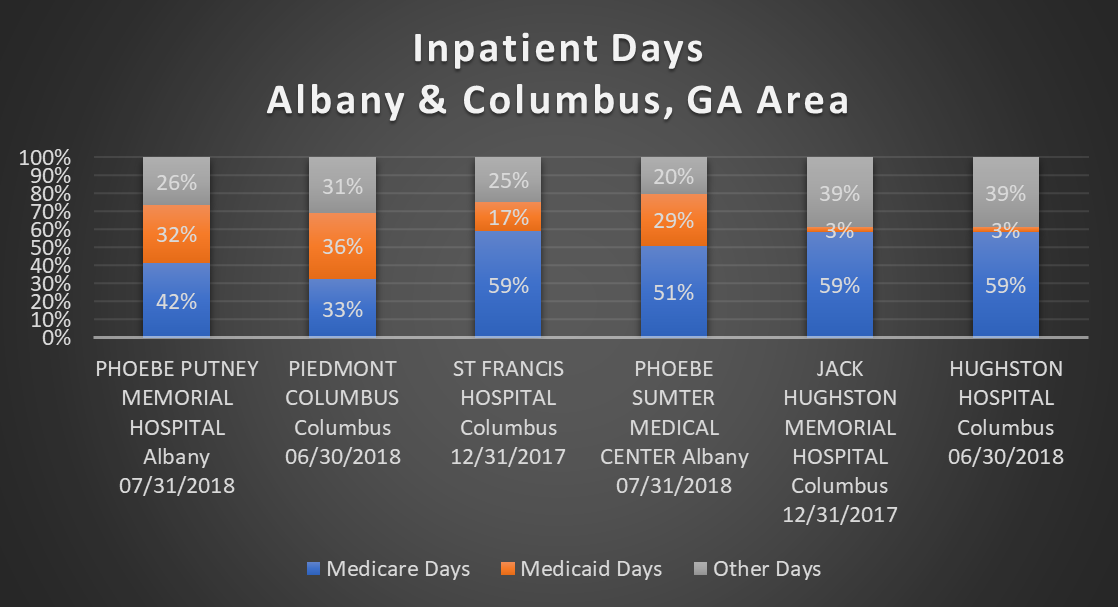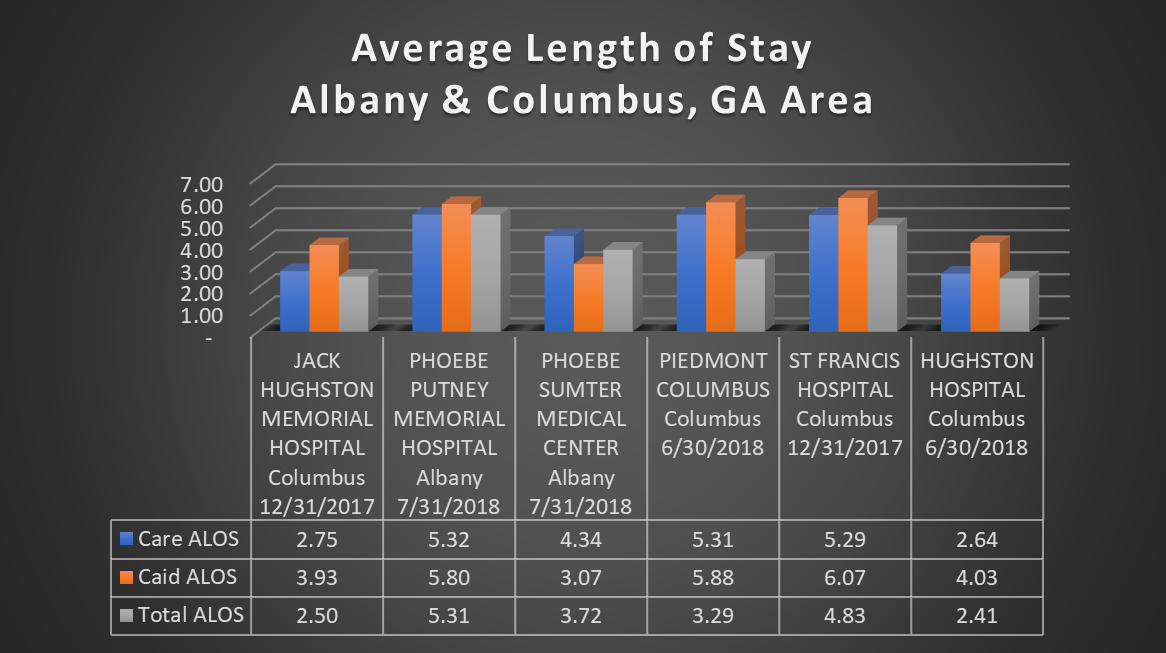Albany & Columbus, Georgia Areas: Beds, Inpatient Days, and Average Length of Stay
Today I want to take a look at how many beds the Albany & Columbus area hospitals have. This will give me an idea of the size of the hospitals. Then, I will look at how many Inpatient days they have. This information can give us an idea of how busy the hospital is, the age of the population (Medicare), and how poor or not quite so poor the area is (Medicaid). Finally, I’ll look at how long the patients are in the hospital, which may indicate how sick the patients are.
I’m looking at these two markets together because Albany only has two hospitals in this data set and Columbus has four. They are small markets and could be vastly different and not easily comparable. We’ll never know though, unless we get started.
Beds
Let’s take a look at how many acute inpatient beds these hospitals have. This is not how many they are licensed to operate, but rather how many are actually staffed. And these are inpatient beds, so it won’t include labor & delivery beds or some other ancillary unit. Also, nursery beds are not included. Just the way CMS rolls.
| Hospital | Market | City | Beds |
|---|---|---|---|
| PHOEBE PUTNEY MEMORIAL HOSPITAL | Albany | ALBANY, GA | 409 |
| ST FRANCIS HOSPITAL | Columbus | COLUMBUS, GA | 312 |
| PIEDMONT COLUMBUS | Columbus | COLUMBUS, GA | 276 |
| HUGHSTON HOSPITAL | Columbus | COLUMBUS, GA | 57 |
| PHOEBE SUMTER MEDICAL CENTER | Albany | AMERICUS, GA | 54 |
| JACK HUGHSTON MEMORIAL HOSPITAL | Columbus | PHENIX CITY, AL | 47 |
Looks like Albany has one large hospital, Phoebe Putney, and Columbus has two, St Francis and Piedmont Columbus. Let’s take a look at how busy these hospitals are.
Bed Utilization
Bed utilization will give us an idea of how often these beds are in service. I’m going to show nursery days for a couple of reasons. First, nursery beds are not reported on the cost report, so nursery days would need to be removed for calculating utilization. Some hospitals report the nursery days with adults & peds, so seeing this will just clue us in that their bed utilization will be skewed. Smaller hospitals, though, generally don’t have nurseries. They leave that line of service to the bigger hospitals.
| Hospital | Market | Inpatient Days | Nursery Days | Bed Utilization |
|---|---|---|---|---|
| PHOEBE PUTNEY MEMORIAL HOSPITAL | Albany | 97,232 | 7,181 | 60.32% |
| PIEDMONT COLUMBUS | Columbus | 83,475 | 8,025 | 67.96% |
| ST FRANCIS HOSPITAL | Columbus | 68,611 | 2,089 | 58.41% |
| PHOEBE SUMTER MEDICAL CENTER | Albany | 11,791 | 1,117 | 54.16% |
| JACK HUGHSTON MEMORIAL HOSPITAL | Columbus | 6,227 | 0 | 36.30% |
| HUGHSTON HOSPITAL | Columbus | 4,967 | 0 | 23.87% |
Overall, these hospitals look pretty busy. The two smaller hospitals may have swing beds, which can be used for lower level of care services. If so, their utilization would be understated as I’m not including those days in the calculation.
Next, let’s take a look at how many Medicare and Medicaid inpatients these hospitals have.
Medicare & Medicaid Day Utilization
Inpatient days are reported by Medicare, Medicaid and Total. The Medicare amount will give us an idea of the age of the population, potentially. The Medicaid total may give us an idea of the poverty levels. I have to point out that it’s a little hard to tell how many Medicaid patients you have if there is a heavy Medicare population. If a patient has Medicare, then they will not be included in the Medicaid day count. We can still infer information, though, from what is reported.

The Columbus area hospitals have a high Medicare population. In a later post, when I look at census data, we’ll look to see if the population age is older. It may just be that they specialize in orthopaedics and that specialty is needed by older people in general.
Phoebe Putney and Piedmont Columbus both have high Meidcaid percentages. They also have a decent amount of nursery days. I’m wondering if these areas have low median incomes. This is something else we’ll find in the census data.
I am noticing a trend where hospitals have 60-70% governmental payors. This can be hard on hospitals when politicians use healthcare legislation to get votes. States balance budgets by cutting Medicaid payments frequently. It can be a really tough industry to be in.
Average Length of Stay
I use this metric to see a few things. Sometimes hospitals will have high length of stays if they have trauma units or NICUs. These patients take longer to heal. Other times hospitals may struggle to find places for their patients to go when they no longer require acute level of care. For instance, a patient may need to go to rehab or skilled nursing, but there’s no available beds in the area. It’s not safe to send the patient home, so the hospitals have to keep them until a bed opens elsewhere. I can’t know for sure what’s going on, but it can be an indication that a need is not being met in a community.

Looks like Phoebe Putney, Piedmont Columbus, and St Francis Hospitals are 6 days length of stays with their Medicare and Medicaid populations. I guess it depends on their service lines, but I was expecting closer to 4 days. Makes me wonder if they are lacking beds in nursing homes or skilled nursing or perhaps even rehab units.
Musing Revelation
I’ve learned that Albany has one large hospital and Columbus has two. Bed utilizations are running around 55-60%, which appears to be the norm (based on my extremely limited knowledge). Medicare and Medicaid inpatients make up roughly 60% of the populations. Medicaid looks low for Jack Hughston Memorial and Hughston Hospital, but perhaps that is due to their high Medicare population. And finally, the ALOS at the larger hospitals seem a little high for Medicare and Medicaid, which may suggest lack of option for lower level of care services. It may just be normal and I don’t know it yet. The ALOS at the smaller hospitals look good though. That’s interesting.
This covers a good portion of Worksheet S-3, Part I on the Medicare Cost Report. All of this data is subject to change at any given time for any number of reasons. My only goal is to look through what is reported to learn more about these hospitals. Hopefully, somewhere along the line you will learn something too.
